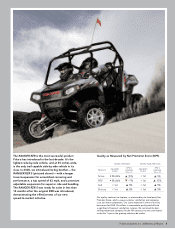Polaris 2008 Annual Report Download - page 21
Download and view the complete annual report
Please find page 21 of the 2008 Polaris annual report below. You can navigate through the pages in the report by either clicking on the pages listed below, or by using the keyword search tool below to find specific information within the annual report.Motorcycles. In 1998, Polaris began manufacturing V-twin cruiser motorcycles under the Victory»brand
name. Polaris’ 2008 model year line of motorcycles consists of eleven models including its first luxury touring
models, the Victory Vision Street
TM
and Victory Vision Tour
TM
. Suggested United States retail prices for the 2009
model year Victory motorcycles ranged from approximately $13,800 to $29,000.
Parts, Garments and Accessories. Polaris produces or supplies a variety of replacement parts and accessories
for its ORVs, snowmobiles, motorcycles and personal watercraft. ORV accessories include winches, bumper/
brushguards, plows, racks, mowers, tires, pull-behinds, cabs, cargo box accessories, tracks and oil. Snowmobile
accessories include products such as covers, traction products, reverse kits, electric starters, tracks, bags, wind-
shields, oil and lubricants. Motorcycle accessories include saddle bags, handlebars, backrests, exhaust, windshields,
seats, oil and various chrome accessories. Polaris also markets a full line of recreational apparel including helmets,
jackets, bibs and pants, leathers and hats for its snowmobile, ORV, and motorcycle lines. The apparel is designed to
Polaris’ specifications, purchased from independent vendors and sold by Polaris through its dealers and distributors,
and online through its e-commerce subsidiary under the Polaris brand name.
Discontinued Operations — Marine Products. Polaris entered the personal watercraft (“PWC”) market in
1992. On September 2, 2004, the Company announced that it had decided to cease to manufacture marine products
effective immediately. As technology and the distribution channel evolved, the marine division’s lack of com-
monality with other Polaris product lines created challenges for Polaris and its dealer base. The marine division
continued to experience escalating costs and increasing competitive pressures and was never profitable for Polaris.
See Note 9 of Notes to Consolidated Financial Statements for a discussion of the discontinuation of marine
products.
Manufacturing and Distribution Operations
Polaris’ products are assembled at its original manufacturing facility in Roseau, Minnesota and at its facilities
in Spirit Lake, Iowa and Osceola, Wisconsin. Since snowmobiles, ORVs and motorcycles incorporate similar
technology, substantially the same equipment and personnel are employed in their production. Polaris is vertically
integrated in several key components of its manufacturing process, including plastic injection molding, stamping,
welding, clutch assembly and balancing, painting, cutting and sewing, and manufacture of foam seats. Fuel tanks,
tracks, tires and instruments, and certain other component parts are purchased from third party vendors. Polaris
manufactures a number of other components for its snowmobiles, ORVs, and motorcycles. Raw materials or
standard parts are readily available from multiple sources for the components manufactured by Polaris. Polaris’
work force is familiar with the use, operation and maintenance of the products, since many employees own
snowmobiles, ORVs, and motorcycles. In 1991, Polaris acquired a manufacturing facility in Osceola, Wisconsin to
manufacture component parts previously produced by third party suppliers. In 1994, Polaris acquired a manu-
facturing facility in Spirit Lake, Iowa in order to expand the assembly capacity of the Company. Certain operations,
including engine assembly and the bending of frame tubes, seat manufacturing, drivetrain and exhaust assembly and
stamping are conducted at the Osceola, Wisconsin facility. In 1998, Victory motorcycle production began at Polaris’
Spirit Lake, Iowa facility. The production process in Spirit Lake includes welding, finish painting, and final
assembly. In early 2002, Polaris completed the expansion and renovation of its Roseau manufacturing facility,
which resulted in increased capacity and enhanced production flexibility.
Pursuant to informal agreements between Polaris and Fuji Heavy Industries Ltd. (“Fuji”), Fuji was the sole
manufacturer of Polaris’ two-cycle snowmobile engines from 1968 to 1995. Fuji has manufactured engines for
Polaris’ ATV products since their introduction in the spring of 1985. Fuji develops such engines to the specific
requirements of Polaris. Polaris believes its relationship with Fuji to be excellent. If, however, Fuji terminated its
relationship, interruption in the supply of engines would adversely affect Polaris’ production pending the continued
development of substitute supply arrangements.
In addition, Polaris entered into an agreement with Fuji to form Robin Manufacturing, U.S.A. (“Robin”) in
1995. Under the agreement, Polaris made an investment for a 40% ownership position in Robin, which builds
engines in the United States for recreational and industrial products. See Note 7 of Notes to Consolidated Financial
Statements for a discussion of the Robin agreement.
3
























